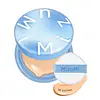What's inside
What's inside
 Key Ingredients
Key Ingredients

 Benefits
Benefits

 Concerns
Concerns

 Ingredients Side-by-side
Ingredients Side-by-side

Water
Skin ConditioningCyclopentasiloxane
EmollientEthylhexyl Methoxycinnamate
UV AbsorberTrimethylsiloxysilicate
EmollientGlycerin
HumectantIsododecane
EmollientCetyl PEG/PPG-10/1 Dimethicone
EmulsifyingSilica
AbrasiveNylon-12
Dimethicone/Vinyl Dimethicone Crosspolymer
Skin ConditioningDisteardimonium Hectorite
StabilisingMagnesium Sulfate
Phenyl Trimethicone
Skin ConditioningPhenoxyethanol
PreservativeIsononyl Isononanoate
EmollientBis-Diglyceryl Polyacyladipate-2
EmollientAluminum Hydroxide
EmollientTriethoxycaprylylsilane
Chlorphenesin
AntimicrobialButylene Glycol
Humectant1,2-Hexanediol
Skin ConditioningSodium Hyaluronate
HumectantHydrolyzed Hyaluronic Acid
HumectantSodium Acetylated Hyaluronate
HumectantThymus Serpyllum Extract
Skin ConditioningMaltodextrin
AbsorbentEchinacea Purpurea Extract
MoisturisingRhodiola Rosea Extract
EmollientWater, Cyclopentasiloxane, Ethylhexyl Methoxycinnamate, Trimethylsiloxysilicate, Glycerin, Isododecane, Cetyl PEG/PPG-10/1 Dimethicone, Silica, Nylon-12, Dimethicone/Vinyl Dimethicone Crosspolymer, Disteardimonium Hectorite, Magnesium Sulfate, Phenyl Trimethicone, Phenoxyethanol, Isononyl Isononanoate, Bis-Diglyceryl Polyacyladipate-2, Aluminum Hydroxide, Triethoxycaprylylsilane, Chlorphenesin, Butylene Glycol, 1,2-Hexanediol, Sodium Hyaluronate, Hydrolyzed Hyaluronic Acid, Sodium Acetylated Hyaluronate, Thymus Serpyllum Extract, Maltodextrin, Echinacea Purpurea Extract, Rhodiola Rosea Extract
Water
Skin ConditioningCI 77891
Cosmetic ColorantDiphenylsiloxy Phenyl Trimethicone
Skin ConditioningMethyl Trimethicone
Skin ConditioningButylene Glycol
HumectantHomosalate
Skin ConditioningIsododecane
EmollientTitanium Dioxide
Cosmetic ColorantCaprylyl Methicone
Skin ConditioningAcrylates/Polytrimethylsiloxymethacrylate Copolymer
Skin ConditioningLauryl Polyglyceryl-3 Polydimethylsiloxyethyl Dimethicone
Skin ConditioningPolyglyceryl-6 Polyricinoleate
EmulsifyingCI 77492
Cosmetic ColorantMica
Cosmetic Colorant1,2-Hexanediol
Skin ConditioningDisteardimonium Hectorite
StabilisingSodium Chloride
MaskingAluminum Hydroxide
EmollientPolyglyceryl-2 Isostearate
EmulsifyingVinyl Dimethicone/Methicone Silsesquioxane Crosspolymer
Silica
AbrasiveCI 77491
Cosmetic ColorantStearic Acid
CleansingTriethoxycaprylylsilane
CI 77499
Cosmetic ColorantCaprylyl Glycol
EmollientGlyceryl Caprylate
EmollientTrihydroxystearin
Skin ConditioningMethicone
EmollientXanthan Gum
EmulsifyingDisodium EDTA
Tocopherol
AntioxidantWater, CI 77891, Diphenylsiloxy Phenyl Trimethicone, Methyl Trimethicone, Butylene Glycol, Homosalate, Isododecane, Titanium Dioxide, Caprylyl Methicone, Acrylates/Polytrimethylsiloxymethacrylate Copolymer, Lauryl Polyglyceryl-3 Polydimethylsiloxyethyl Dimethicone, Polyglyceryl-6 Polyricinoleate, CI 77492, Mica, 1,2-Hexanediol, Disteardimonium Hectorite, Sodium Chloride, Aluminum Hydroxide, Polyglyceryl-2 Isostearate, Vinyl Dimethicone/Methicone Silsesquioxane Crosspolymer, Silica, CI 77491, Stearic Acid, Triethoxycaprylylsilane, CI 77499, Caprylyl Glycol, Glyceryl Caprylate, Trihydroxystearin, Methicone, Xanthan Gum, Disodium EDTA, Tocopherol
Ingredients Explained
These ingredients are found in both products.
Ingredients higher up in an ingredient list are typically present in a larger amount.
1,2-Hexanediol is a synthetic liquid and another multi-functional powerhouse.
It is a:
- Humectant, drawing moisture into the skin
- Emollient, helping to soften skin
- Solvent, dispersing and stabilizing formulas
- Preservative booster, enhancing the antimicrobial activity of other preservatives
Aluminum Hydroxide is a form of aluminum. It can be naturally found in nature as the mineral gibbsite. In cosmetics, Aluminum Hydroxide is used as a colorant, pH adjuster, and absorbent.
As a colorant, Aluminum Hydroxide may add opacity, or reduce the transparency. Aluminum hydroxide is contains both basic and acidic properties.
According to manufacturers, this ingredient is an emollient and humectant. This means it helps hydrate the skin.
In medicine, this ingredient is used to help relieve heartburn and help heal ulcers.
There is currently no credible scientific evidence linking aluminum hydroxide in cosmetics to increased cancer risk.
Major health organizations allow the use of aluminum hydroxide in personal care products and have not flagged it as a carcinogenic risk at typical usage levels.
Learn more about Aluminum HydroxideButylene Glycol (or BG) is used within cosmetic products for a few different reasons:
Overall, Butylene Glycol is a safe and well-rounded ingredient that works well with other ingredients.
Though this ingredient works well with most skin types, some people with sensitive skin may experience a reaction such as allergic rashes, closed comedones, or itchiness.
Learn more about Butylene GlycolDisteardimonium Hectorite comes from the clay mineral named hectorite. It is used to add thickness to a product.
It can also help stabilize a product by helping to disperse other ingredients.
Hectorite is a rare, white clay mineral.
Learn more about Disteardimonium HectoriteIsododecane is a fragrance, emollient, and solvent.
As an emollient, it helps your skin stay soft and hydrated. Emollients help trap moisture into your skin.
Isododecane's role as a solvent makes it a great texture enhancer. It spreads smoothly on skin and does not leave a sticky feeling behind. Isododecane also helps prevent color transfer in makeup products.
Isododecane is not absorbed into skin.
Learn more about IsododecaneSilica, also known as silicon dioxide, is a naturally occurring mineral. It is used as a fine, spherical, and porous powder in cosmetics.
Though it has exfoliant properties, the function of silica varies depending on the product.
The unique structure of silica enhances the spreadability and adds smoothness, making it a great texture enhancer.
It is also used as an active carrier, emulsifier, and mattifier due to its ability to absorb excess oil.
In some products, tiny microneedles called spicules are made from silica or hydrolyzed sponge. When you rub them in, they lightly polish away dead skin layers and enhance the penetration of active ingredients.
Learn more about SilicaTriethoxycaprylylsilane is a silicone used to bind and stabilize ingredients.
As an emulsifier, it helps prevent ingredients from separating. This can help elongate the shelf life of products.
Triethoxycaprylylsilane is often used to coat mineral sunscreens ingredients to help give a better feel. It also helps reduce oxidative stress in sunscreens.
Learn more about TriethoxycaprylylsilaneWater. It's the most common cosmetic ingredient of all. You'll usually see it at the top of ingredient lists, meaning that it makes up the largest part of the product.
So why is it so popular? Water most often acts as a solvent - this means that it helps dissolve other ingredients into the formulation.
You'll also recognize water as that liquid we all need to stay alive. If you see this, drink a glass of water. Stay hydrated!
Learn more about Water